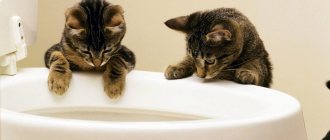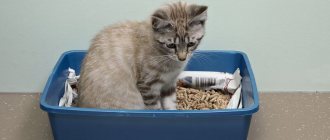Toilet training is something that many cat owners take for granted. Even rescued cats seem to instinctively know how to use the litter box by copying their mothers. However, some felines may not have survived this important socialization. Thus, older cats may need to be toilet trained from scratch or they will defecate outside the litter box.
Do not use a covered litter box as this may frighten a cat who is not familiar with the process. Use unscented litter that is similar to your cat's usual outdoor surfaces. Leave the litter box in a place where the cat can have privacy, such as behind a plant.
An adult cat can learn to use the litter box correctly after training. There may be a little confusion along the way, such as sleeping in a litter box. Over time, your cat will begin to understand what is expected of her.
Why doesn't an adult cat use the litter box?
Some cats are homeless or feral. This means they never received the socialization needed to become a pet. Sometimes a kitten is born into the family home but is rejected by its mother.
This means he was never taught basic functions. Some cats are also abused by other pets. This could make them afraid to use the litter box due to the smell. Another animal could even "stand guard" over the litter box, preventing your cat from entering.
© shutterstock
What to do if you catch a kitten in flagrante delicto
At the moment when you see a puddle on the floor or on the sofa, you should not give in to aggression. Yes, an unpleasant sight. But with your screaming or assault, you will only frighten the little kitten even more.
First of all, you need to force yourself to calm down. In this case, you can dip a napkin in the puddle and put it in the tray, then place the kitten in it. The baby must understand that he needs to go to the toilet here. It would be good to rinse the “wet area” with water and strong-smelling disinfectants.
Teaching an adult cat to use the litter box
Cats are smart animals. This means that even the grumpiest adult cat can be trained to defecate in the litter box. You need to make the experience attractive to her.
- Do not use a closed litter box . Covering the litter box with a hinged lid will hide the sight and smell of cat waste. However, cats feel vulnerable when they are doing their thing. If they are inside a strong box with no easy way out, they may become stressed.
- Do not use scented litter . If you have a cat that is not spayed, his urine will smell strong. Resist the temptation to mask it with a flavorful filler. Cats are led by the nose. If they find the smell of the litter box scary, they will stay away.
- Have multiple trays . You might think it would be helpful if your cat only has one litter box. However, they will learn faster if they have multiple toilets.
- Make the trays uniform in size and shape . They should have low edges so that an adult cat can get in and out easily. However, you can experiment with different brands of litter.
Once you've completed these basic steps, you'll be ready to begin toilet training. Once you have the proper equipment, all you need is patience. This is a different problem than when your cat suddenly stops using the litter box.
Toilet in the apartment
How to train a kitten to use the toilet in an apartment? Not all owners have the opportunity to take their pet outside after each feeding, especially since in the courtyard of a multi-story building there are many hidden dangers, ranging from physical injuries to infectious and invasive diseases. Therefore, it is advisable to accustom the kitten to the toilet in the apartment. To develop a strong habit, you need to take your baby to the place where the tray will be or is already located. When choosing a place for a cat's litter box, you need to take into account several nuances: cats do not like to be looked at during such a delicate task, the tray should be easy to get from this place.
How to litter train an adult cat
Litter training an older cat is similar to training a kitten. The only difference is that it will take longer. Young cats have spongy brains that take in a lot of information. They also imitate other cats. An older cat will have learned different habits and therefore may appear more stubborn.
Think carefully about where to place the tray. As cats get older, they lose control of their bladder. This means they will appreciate trays in multiple locations.
If you live in a multi-story building, it is very important to have at least one litter box on each floor. Place litter boxes where your cat can find them, but not in an area that is too open. Make sure you keep the litter box a reasonable distance from your cat's bed and food.
If your cat is determined to eliminate, calmly pick her up and place her in the litter box. As soon as she does the deed, make a big fuss. Tell your cat how good she is and give her a treat. Soon, using the litter tray will become a source of pleasure for him.
© shutterstock
Ways to help a kitten get things done
How to help a kitten go to the toilet? You can use enemas, the most effective are Microlax for children from zero years of age (after insertion, the anus must be closed with the tail, otherwise the microenemas will be of no use, and wait a little). In addition to the enema, massage the tummy in a clockwise circular motion. If feces appear from the anus, but cannot come out on their own, you need to begin to quietly and very carefully push it out. The kitten needs to be shown to a veterinarian not only if he was unable to go, but also for preventive purposes.
An adult cat has stopped going to the litter box
There are many reasons why an older cat may stop using the litter box. These may be medical or psychological. Some of the problems that can cause urinary incontinence in older cats may include:
- Stress . The most common reasons why cats stop using the litter box are stress and anxiety. If something has changed in your home, your cat may have difficulty adapting.
- Diarrhea . If your cat has an upset stomach, she may have intended to use the litter box but didn't get around to it.
- Urinary tract infections or bladder stones . A cat with a UTI may make regular, fruitless trips to the litter box. Since it will be painful, he may think the problem is with the bedding. If your cat cries during elimination, she may have a UTI and require antibiotics.
- Old age . As cats get older, they may develop feline dementia (cognitive dysfunction). Loss of bladder and bowel control is one of the first symptoms.
However, there may be another reason why an older cat does not use the litter box. Make sure none of the following is the problem:
- Mobility . An adult cat with stiff and wobbly legs may struggle to reach the litter box.
- Not enough privacy . Cats want to go to the toilet in peace. If the litter box is too close to people or their food bowl, cats will feel uncomfortable.
- Negative associations . Has your cat recently recovered from a health problem? She may think that using the litter tray made her sick.
- Changing your routine . Have you moved the tray or changed the filling in it? Adult felines are easily disturbed by this change.
- Too much filler . Cats love shallow bedding. If you apply too much, it may avoid going into the tray.
- Contaminated litter . Are you changing the litter in the litter tray enough? If your cat's litter is dirty, she may not want to get too close. Make sure the litter box is cleaned at least once a day.
- Territorial problems with another cat . If another cat is dominant over your adult pet, she may view the litter box as her territory.
There is also a chance that your cat will choose to get rid of something else. You can fix this by changing their filler.
Article Author: Richard Parker I'm Richard, I have experience in all matters related to feline health, behavior, grooming techniques and general pet care. Richard graduated with a degree in journalism in 2008. He is the proud owner of 5 adult cats (all adopted stray breeds), including an older cat who is now 20 years old.
Recommendations
How to get a kitten to go to the toilet? After feeding, carefully and at the same time firmly fix the pet so that it cannot slip out. The fingers of the hand should be located simultaneously under the chest and stomach, so that the tail is towards the caregiver. You need to put a damp, warm napkin on your other hand, preferably white, but you can also use light colors, because it’s easier to tell on a light fabric whether the kitten went to the toilet or not.
Next, you need to stimulate the baby to urinate. Do not apply strong pressure and wipe the area from the lower abdomen to the anus. If the kitten went to the toilet (did not defecate - wiping continues), then you need to move to the anal area, doing a specific massage. Usually the effect occurs within a minute. But it happens that animals cannot go even after several feedings. Then you need to show him to a veterinarian.
After the job is done, you must first wipe the contaminated areas of the skin with a clean edge of the napkin (urine and feces are irritating, and dermatitis or a genitourinary tract infection may develop at the site of their appearance, since there is no strong immunity yet formed). It is also necessary to dry wet areas. This procedure is done for each kitten.
If there are several children, separate napkins are allocated for each of them (these can be pieces of bandage, gauze, cotton pads, which are thrown away after use). The whole procedure must take place in a warm room without drafts, otherwise the baby will become hypothermic and die.
Simple rules for choosing a tray
The models of trays on the market can be divided into three groups: with a standard side, with a high side and closed.
A standard side is suitable for neat animals that do not scatter litter - such options are usually compact and economical. A high side is necessary if the animal prefers to actively rummage before doing business. But it can create difficulties for injured, sick or elderly pets. Such models are usually produced without a grille, with a removable protective side that prevents sand from spilling.
Tray houses are an ideal option for pets that spray urine, as well as for shy ones. But for large pets, they may be uncomfortable and simply cramped.
Particularly picky cats may need two trays for different “tasks”. When choosing a container, pay attention to the quality of the plastic - thin trays made of low-quality material do not last long, quickly get scratched, become covered with plaque and begin to smell bad, and sometimes even crack.
Popular sections:
Aquariums Sale of kittens and puppies Terrariums Products for cats Products for dogs
To each his own
First of all, all owners who want to accustom their pet to a civilized trip to the toilet should remember that helping a kitten and an adult animal need to be done differently. The only similarity between them is that the tray is something new and unknown for them. Therefore, it will take time for the cat to understand where the new place is now to relieve itself. And you, as the owner, must take on the role of a patient teacher in this difficult matter.
Usually, if an animal once went to the wrong place, then the next time there is a high probability that it will go to the same place.
Why? Because the cat found the designated place for the toilet by smell (in her opinion). And if at this turning point you do not begin to accustom the cat to the new rules, it will subsequently be very difficult to retrain the cat. Start your training with three important points.
© shutterstock
What to avoid?
It is strictly not recommended to strictly punish a cat for mistakes. Under no circumstances should you humiliate an animal, poke its face in feces, shout or spank it. Cats are very sensitive to violation of personal boundaries, quickly lose trust and form unpleasant associations with the litter box and the process of emptying in general. If handled incorrectly, the pet will decide that shitting is generally bad, and will begin to look for “nicks” in order to relieve itself without the knowledge of the owner, in secret. It is much more difficult to retrain such an animal than simply an ignorant one.
Also try to avoid loud noises while the cat is in the process. Don’t drive it away right away, let it dig around without haste.
Method No. 1 – “Gradual”
The recommendation to move the tray gradually, every day for a very short distance, can be read in every second article, the authors of which draw inspiration from each other’s creativity. I just imagine a tray gradually migrating from under the bed in the bedroom to the corner of the toilet, through the entire bedroom, corridor, hallway. I wonder how to implement this in practice. And will the cat agree to perform such intimate affairs in the aisle, even if she is already accustomed to the litter box?
However, the method may work if you need to move the tray a short distance within the same room.
However, more often than not, things are not at all as the authors of the articles imagine. My first cat, for example, chose a place for her toilet under the kitchen sink. She began to walk steadily and confidently into the tray that was placed there in just a couple of days. However, when trying to move her toilet even a little, she went exactly to the same place, ignoring the convenient “potty”. And it all started all over again: I wash the floor under the sink (and this, I tell you, was not easy in a 5-meter kitchen filled with furniture), put a litter box, monitor the cat for several days, make sure that the habit of using the litter box has developed, and make a new attempt move the tray (it’s very inconvenient to take it out to wash and put it back) - and with the same result.
So I switched to plan B.











